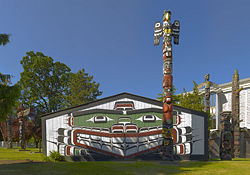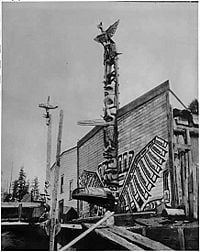Kwakwaka'wakw
Until the 1980s the term Kwakiutl was usually applied to all of the various First Nations peoples of northern Vancouver Island, Queen Charlotte Strait and the Johnstone Strait whose traditional Wakashan language was Kwak'wala and also a group of peoples erroneously called for many years the "Northern Kwakiutl", who are speakers of the related languages Haisla, Oowekyala (Owekeeno) and Heiltsuk, which are also Wakashan. Over time those First Nations began to resurrect and insist on the use of their own names for themselves and Kwakiutl, pronounced something like "kwag-yewlth", came to refer more specifically to the First Nation whose home community was at Fort Rupert near Port Hardy. The preferred collective term for these nations became "Kwakwaka'wakw" which means, those who speak the language Kwak'wala, although one Kwakwaka'wakw tribal council oranization continues to style itself the Kwakiutl District Council.
The Kwakwaka'wakw (also Kwakiutl) are an Indigenous nation, numbering about 5,500, who live in British Columbia on northern Vancouver Island and the mainland. Kwakwaka'wakw translates into "Kwak'wala speaking tribes", describing the collective tribes within their nation. Their language, now spoken by less than 5% of the population (about 250 people), is Kwak'wala. The Kwakwaka'wakw are known for their history, culture and art. In recent years, the Kwakwaka'wakw have been active on the revitalization of their culture and language.
History

The Kwakwaka'wakw are made up of 17 tribes who all speak the common language of kwak'wala. Their society was highly stratified, with three main classes, determined by heredity: nobles, commoners, and slaves. Their economy was based primarily on fishing, with the men also engaging in some hunting, and the women gathering wild fruits and berries. Ornate weaving and woodwork were important crafts, and wealth, defined by slaves and material goods, was prominently displayed and traded at potlatch ceremonies. These customs were the subject of extensive study by the anthropologist Franz Boas. In contrast to European societies, wealth was not determined by how much you had, but by how much you had to give away. This act of giving away your wealth was one of the main acts in a potlatch.
Disease, which developed as a result of direct contact with European settlers along the West Coast of Canada, drastically reduced the Indigenous Kwakwaka'wakw population during the late nineteenth-early twentieth century.
First contact
Colonization
Residential School
Post-colonization
Territory

The Tribes
The Kwakwaka'wakw are organized into 17 different tribes. Each tribe has its own history, culture, and peoples, but remain collectively similar as they are all kwak'wala speaking peoples.
- Kwagu'ł (Fort Rupert)
- Mamalilikala (Village Island)
- 'Namgis (Nimpkish-Cheslakees)
- Awit'sis (Turnour Island)
- A'wa'et'ala (Knight Inlet)
- Da'naxda'xw (New Vancouver)
- Ma'amtagila (Etsekin)
- Dzawada'enux (Kingcome Inlet)
- Kwikwasut'inux (Gilford Island)
- Gwawa'enux (Hope Town)
- 'Nak'waxda'xw (Blunden Harbour)
- Gwa'sala (Smith's Inlet)
- Gusgimukw (Quatsino)
- Gwat'sinux (Winter Harbour)
- T'lat'lasikwala (Hope Island)
- Weka'yi (Cape Mudge)
- Wiwekam (Campbell River)
Culture and Society
The Kwakwaka'wakw are highly stratified bilineal culture of the Pacific Northwest. The Kwakwaka'wakw as a whole make up 17 separate tribes, each with their own history, culture and governance. Commonly among the tribes, there would be a tribal chief, who acted as the head chief of the entire tribe, then below him numerous clan or family chiefs. In some of the tribes, their also existed Eagle Chiefs, but this was a separate society within the main society and apart of the potlatching only. The Kwakwaka'wakw are one of the few bilineal cultures. Traditionally the rights of the family would be passed down through the patrineal side, but in rare occasions, one could take the matrinieal side of their family also. Within the pre-colonization times, the Kwakwaka'wakw were made up of three classes; nobles, commoners, and slaves. The Kwakwaka'wakw shared many cultural and political alliances with numerous neighbors in the area including the Nuu-chah-nulth, Heiltsuk, Wuikinuxv and some Coast Salish.
Language
- Main article: kwak'wala
Potlatch
- Main article: Potlatch
The potlatch culture of the Northwest is famous and widely-studied and remains alive in Kwakwaka'wakw, as does the lavish artwork for which their people and their neighbours are so renowned. The phenomenon of the potlatch and the vibrant societies and cultures associated with it can be found in Chiefly Feasts: The Enduring Kwakiutl Potlatch , which details the incredible artwork and legendary material that go with the other aspects of the potlatch, and gives a glimpse into the high politics and great wealth and power of the Kwakwaka'wakw chiefs.
Art
- Main article: Kwakwaka'wakw art
Music
- Main article: Kwakwaka'wakw music
War
Mythology
- Main article: Kwakwaka'wakw mythology
Food
The Kwakiutl lived in the Northwest Coast region and were excellent hunters, fishers, and gatherers. They mainly ate berries for fruit and the major catches for fish was Salmon traveling upriver in the summer. They sometimes went whale harpooning. The trip could last for days while the whale was being stalked. The wealthiest sometimes threw potlatches or giveaways where they would give most of their possessions to the guests as a way to show wealth and power.
Notable Kwakwaka'wakw
- David Neel
- James Sewid
- George Hunt (ethnologist)
- Calvin Hunt
- Henry Hunt (artist)
- Richard Hunt (artist)
- Tony Hunt (artist)
- Mungo Martin
Footnotes
- ↑ Thunderbird Park – A Place of Cultural Sharing. Royal British Columbia Museum. Retrieved 2006-06-24. House built by Mungo Martin and David Martin with carpenter Robert J. Wallace. Based on Chief Nakap'ankam's house in Tsaxis (Fort Rupert). The house "bears on its house-posts the hereditary crests of Martin's family." It continues to be used for ceremonies with the permission of Chief Oast'akalagalis 'Walas 'Namugwis (Peter Knox, Martin's grandson) and Mable Knox. Pole carved by Mungo Martin, David Martin and Mildred Hunt. "Rather than display his own crests on the pole, which was customary, Martin chose to include crests representing the A'wa'etlala, Kwagu'l, 'Nak'waxda'xw and 'Namgis Nations. In this way, the pole represents and honours all the Kwakwaka'wakw people."
- Chiefly Feasts: The Enduring Kwakiutl Potlatch Aldona Jonaitis (Editor) U. Washington Press 1991 (also a publication of the American Museum of Natural History)
- Bancroft-Hunt, Norman. People of the Totem: The Indians of the Pacific Northwest University of Oklahoma Press, 1988
See also
- Kwakwaka'wakw mythology
- Kwak'wala (language)
- In the Land of the Head Hunters
- Laich-kwil-tach - Southern Kwakiutl
- Kwakiutl District Council
External links
Credits
New World Encyclopedia writers and editors rewrote and completed the Wikipedia article in accordance with New World Encyclopedia standards. This article abides by terms of the Creative Commons CC-by-sa 3.0 License (CC-by-sa), which may be used and disseminated with proper attribution. Credit is due under the terms of this license that can reference both the New World Encyclopedia contributors and the selfless volunteer contributors of the Wikimedia Foundation. To cite this article click here for a list of acceptable citing formats.The history of earlier contributions by wikipedians is accessible to researchers here:
The history of this article since it was imported to New World Encyclopedia:
Note: Some restrictions may apply to use of individual images which are separately licensed.
